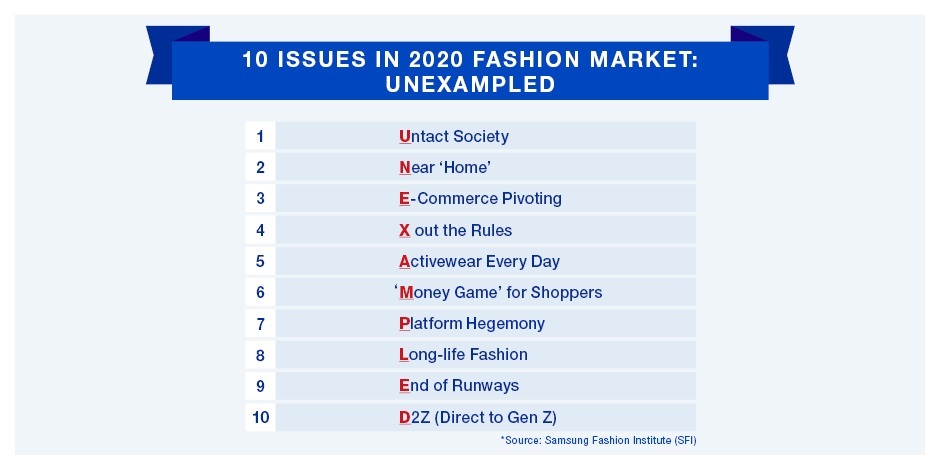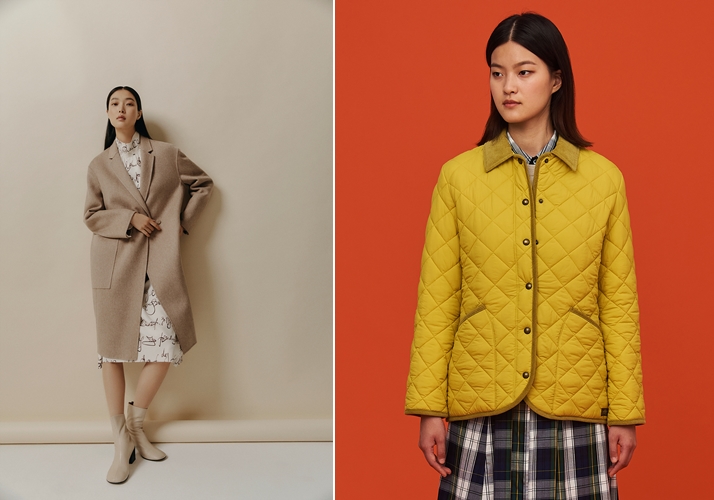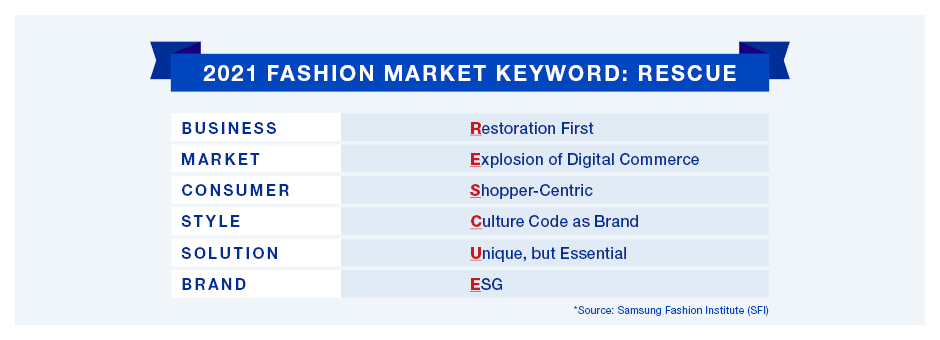The last year has brought many changes to the world – more than in previous years – because of COVID-19. The fashion industry was no exception. The Samsung Fashion Institute has proclaimed 2020 an “UNEXAMPLED,” or unprecedented, year.
The pandemic has sparked a transition towards an “untact” society, a new term coined in South Korea to describe living while avoiding contact with other people as much as practically possible. Thanks to this trend, our everyday lives are all happening in or near home, giving birth to the one-mile wear trend. At the same time, consumers are making a pivot towards e-commerce, so now online shopping accounts for 30% of total fashion sales this year. This in turn is accelerating the launches of online-only brands.
The COVID-19 new normal also crosses out existing rules, allowing comfort and practicality to take center stage. As a result, face masks have become a fashion item, while “seasonless” clothes, wearable all year round, are becoming increasingly popular. Activewear, originally for sports activities, has also now become everyday clothing.
Meanwhile, consumption has become a kind of shoppers’ “money game.” An economic downturn sparked by COVID-19 encourages consumers to prefer items that can retain or even increase their value for resale later. Online platforms that offer both entertainment and shopping are increasingly dominating existing retail channels, as they can attract people to come to a platform for one thing but stick around for more.
At the same time, interest in sustainability is continuing to grow as the pandemic has also raised awareness for the environment. Long-life fashions such as garments and shoes made of eco-friendly materials are proving increasingly popular. In combination with this, social distancing and lockdowns have put a damper on many fashion shows this year, making some wonder if this means the end of runways. Brands are also seeking to appeal directly to Gen Z, the generation at the center of the growing contactless lifestyle. The fashion industry is restructuring around the digital native cohort who help turn new micro-trends into mainstream ones in about a year on average.
2021 in need of a RESCUE
So what will 2021 hold for the fashion industry? Just as we need vaccines and therapeutics to restore our usual lives from COVID-19, the Samsung Fashion Institute suggests that the fashion industry requires a recovery in scale and a reform. In other words it needs a “RESCUE.”
Business / RESCUE – Restoration first
From a business point of view, 2021 seems to be the time to prioritize a recovery of scale by boosting consumer sentiment. As consumption behaviors that have changed once do not revert easily to old patterns, trend industries such as fashion need time to pick up and move on again, and efforts should be made to re-examine and improve processes that had been seen as the customary and normal way to do things.
Market / RESCUE – Explosion of Digital Commerce
In the marketplace, digital commerce is expected to continue grow explosively in 2021. Live-streaming e-commerce, currently still in its infancy, will become a more everyday shopping channel, and the growth of online channels will be further accelerated by the development of technologies to remove various barriers that make consumers hesitant to buy online. Offline stores now need to check their efficiency and redefine their role, as they give way to an increasing number of online ones.
Consumer / RESCUE – Shopper-centric
More and more consumers want to live simpler, less cluttered lives. The growth in that trend looks set to diversify what it means to consume, for example with the rise of alternative ways of consumption as well as consumption as investment. It’s now a means of expressing yourself, making shoppers ponder more about what to buy, leading to smaller consumption volumes.
Brand / RESCUE – Culture Code as Brand
To keep pace with this changing meaning of consumption, brands should establish consumer-oriented strategies and directions. Now we are seeing that the power of a brand is determined by content and image, no longer by awareness or popularity. We have to abandon the view that products represent a brand. Which platform products are sold on is now more important than mere brand names, so brands should be approached as a culture that lives and breathes together with their consumers.
Style / RESCUE – Unique, but Essential
Fashion styles now embrace diversity more than ever. Styles that you prefer and that suit your lifestyle become more important than trends led by some famous designers. Practical attitudes that consider comfort and utility will continue, and various ways to express individuality will emerge as strict conceptions of the right time, place and occasion for a given look collapse. What is needed is a strategy that focuses keenly on consumer needs rather than trends.
Solution / RESCUE – ESG (Environmental, Social and Governance)
The fashion industry is changing due to accelerated turns towards both digitalization and sustainability triggered by COVID-19, shaping a new normal that cannot be undone. Amidst the growing calls for the industry to look beyond pure profit making, the hot topic in management circles is the inclusion of environmental, social and governance (ESG) factors in business-making decisions. With this in view, fashion houses should also shift their paradigm towards ESG concerns, especially in this low-growth period.










